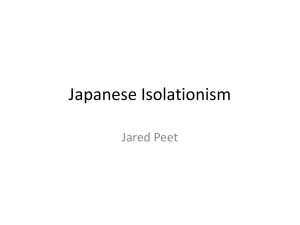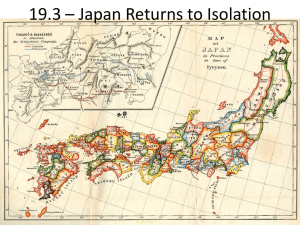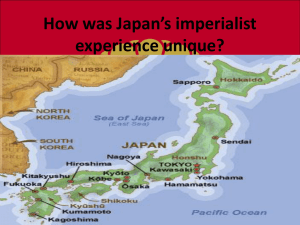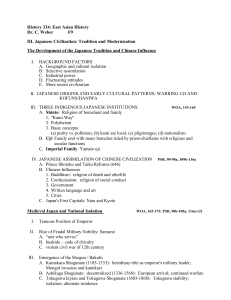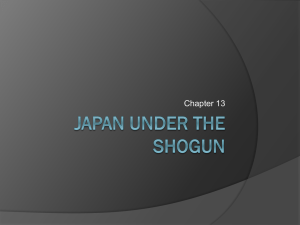sakoku
advertisement
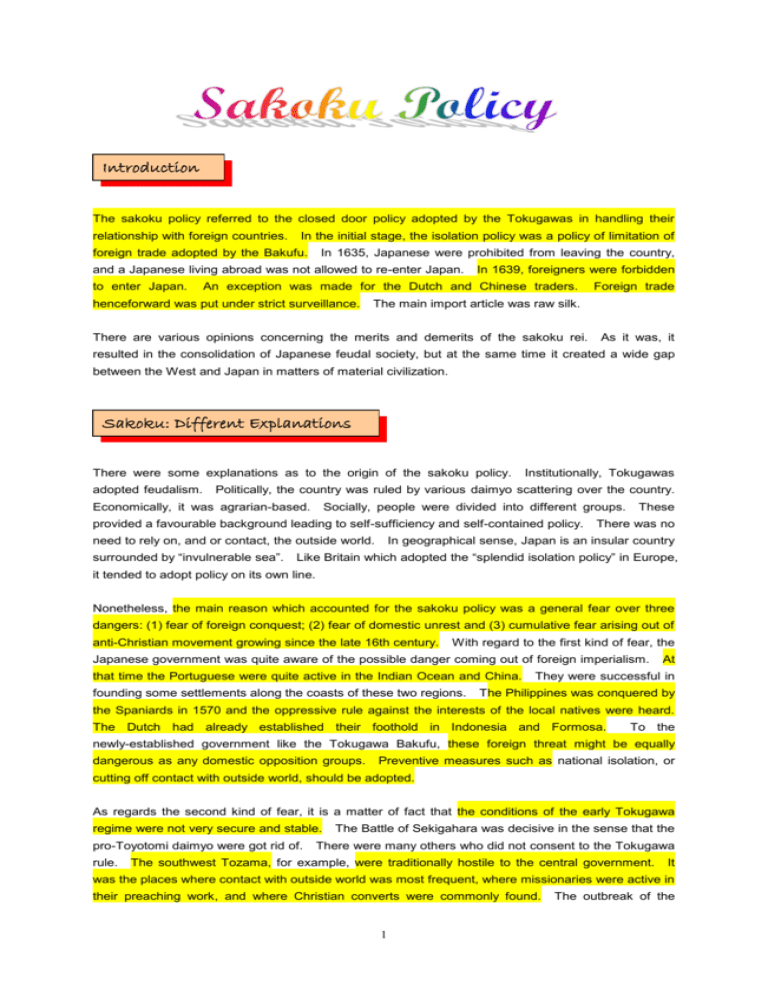
Introduction The sakoku policy referred to the closed door policy adopted by the Tokugawas in handling their relationship with foreign countries. In the initial stage, the isolation policy was a policy of limitation of foreign trade adopted by the Bakufu. In 1635, Japanese were prohibited from leaving the country, and a Japanese living abroad was not allowed to re-enter Japan. to enter Japan. In 1639, foreigners were forbidden An exception was made for the Dutch and Chinese traders. henceforward was put under strict surveillance. Foreign trade The main import article was raw silk. There are various opinions concerning the merits and demerits of the sakoku rei. As it was, it resulted in the consolidation of Japanese feudal society, but at the same time it created a wide gap between the West and Japan in matters of material civilization. Sakoku: Different Explanations There were some explanations as to the origin of the sakoku policy. adopted feudalism. Institutionally, Tokugawas Politically, the country was ruled by various daimyo scattering over the country. Economically, it was agrarian-based. Socially, people were divided into different groups. provided a favourable background leading to self-sufficiency and self-contained policy. need to rely on, and or contact, the outside world. surrounded by “invulnerable sea”. These There was no In geographical sense, Japan is an insular country Like Britain which adopted the “splendid isolation policy” in Europe, it tended to adopt policy on its own line. Nonetheless, the main reason which accounted for the sakoku policy was a general fear over three dangers: (1) fear of foreign conquest; (2) fear of domestic unrest and (3) cumulative fear arising out of anti-Christian movement growing since the late 16th century. With regard to the first kind of fear, the Japanese government was quite aware of the possible danger coming out of foreign imperialism. that time the Portuguese were quite active in the Indian Ocean and China. founding some settlements along the coasts of these two regions. At They were successful in The Philippines was conquered by the Spaniards in 1570 and the oppressive rule against the interests of the local natives were heard. The Dutch had already established their foothold in Indonesia and Formosa. To the newly-established government like the Tokugawa Bakufu, these foreign threat might be equally dangerous as any domestic opposition groups. Preventive measures such as national isolation, or cutting off contact with outside world, should be adopted. As regards the second kind of fear, it is a matter of fact that the conditions of the early Tokugawa regime were not very secure and stable. pro-Toyotomi daimyo were got rid of. rule. The Battle of Sekigahara was decisive in the sense that the There were many others who did not consent to the Tokugawa The southwest Tozama, for example, were traditionally hostile to the central government. It was the places where contact with outside world was most frequent, where missionaries were active in their preaching work, and where Christian converts were commonly found. 1 The outbreak of the Shimabara Rebellion of 1637-38 (島原之亂) was the best evidence. In addition to the Tozama, there were numerous number of masterless samurai, or ronin (浪人). These samurai were particularly discontented with the Tokugawas who destroyed their rice-bowls, privileges and families by confiscating the fiefs of their lords on different grounds or by reducing the size of the fiefs. Some of the samurai became ronin because they had left abroad, only to find that they were no longer needed because of the change of the government‘s foreign policy. Whatever reasons which accounted for their present situation, they vented their wrath against the Tokugawa government. Many of them participated in the large-scale rebellions that took place in the early Tokugawa era, namely, the Osaka Campaign (大阪之役)of 1615 and the Shimabara Rebellion of 1637-38. Richard Storry remarked that they were the “gallant freelance, brawling swashbuckler and bully as well as a social nuisance.” (p. 67) In spite of the explanations given above, many historians, especially C.R. Boxer, believe that the sakoku policy was the end-product of the anti-Christian movement. While the control system was being internally carried out to maintain security of the newly-founded government, the sakoku policy served the same objective against different targets. So, why was it directed against the Christians (the Japanese converts) and later the foreign missionaries? attack against foreign traders and their countries? Why did the government spread its What were the immediate causes of the sakoku policy? Sakoku and Christianity Christianity was introduced into Japan since 1549 when Francis Xavier arrived at Kagoshima(鹿兒島) of Satsuma. Within a short span it spread with great success. In 1582 there were 75 priests and 150,000 converts. The figures increased to 116 priests and more than 300,000 converts in 1614. Two embassies, one led by Valignano and another by Date (伊達)Daimyo, were sent to Rome to pay visits to the Pope. Most of the Christians were found in northwest Kyushu, with Nagasaki(長崎)as their headquarter. Not only the commoners, but also the leading class like the daimyo of Arima(有 馬), Omura (大村), Shimabara(島原)Amakusa(天草)and Higo(肥後)were the believers of Christianity. Considering the factors such as the successful preaching methods, the government‘s adoption of anti-Buddhist policies and the economic benefits accrued from it, the above achievements were by no means accidental. However, Christianity was being suspected by the contemporary leading figures. In 1587 Toyotomi Hideyoshi suddenly issued an edict ordering an expulsion of missionaries. Tokugawa Ieyasu was very cautious about spread of Christianity in Japan. But it was not until the third Shogun, Iemitsu (家 光)that put the sakoku in practice. Why did the Bakufu adopt anti-Christian policies? First and most important of all, the Christians and their activities were believed to be involved with subversive activities in Japan. There were Christians standing on the pro-Toyotomi side at the Battle of Sekigahara (1600). There were two scandals involving the Christian daimyo: the Arima Incident of 1612 and the Okubo Scandal (大久保醜聞)of 1613. A Spanish mariner surveyed the Japanese waters in 1612. If all these individual incidents were not strong evidence showing the anti-government activities of the Japanese Christians, the Osaka Campaign and the Shimbara Rebellion clearly indicated that they did participate in subversive activities. At Osaka, there were bodies of Christian samurai and ronin, crosses and Jesus on the flags, as well as seven missionaries. On the other hand, Shimbara and Amakusa were the Christian 2 bases, with a Jesuit seminary and printing press. The so-called Divine Revelation was a prophecy if not conspiracy. The leader of the rebellion, Amakusa Shiro(天草四郎)was a samurai‘s son of Konishi Yukinaga(小西行長), a pro-Toyotomi daimyo fighting Tokugawa Ieyasu at the Battle of Sekigahara. The second reason is the problem of loyalty. Shogun (or the Tenno in theory). the most respectable figures. government leaders felt. To the Tokugawas, absolute loyalty must be paid to the Yet, to the Christians, God in Heaven and the Pope at Rome are The more they were devoted to Christianity, the more worried the The Tokugawas thought of every possible means to control people‘s mind so that all people would be loyal to the government, how could they put up with 200,000 to 300,000 “dissidents” at home? To suppress Christian movement in Japan, in this light, was a must as far as the security of the Tokugawa regime was concerned. However, to get rid of the complete influence of Christianity at home, foreign countries associated with it had to be dealt with. There were four European powers in Tokugawa Japan: Portugal, Spain, Britain and the Netherlands. Each of them was in rivalry with the other. Personally, Will Adams (三浦按針)had an intimate relationship with Tokugawa Ieyasu. He always had bad words on the Portuguese.1 On the other hand, the Spaniard friars (the Franciscan and Dominican) always jealous of the Portuguese Jesuits.2 At any rate, the most important concern of the Tokugawas was both Portugal and Spain brought goods and Christianity to Japan. Previously, because of handsome profits accrued from trading with them, the Bakufu permitted their missionaries to come together with the traders and to preach in the country. The Bakufu leaders like Ieyasu had to weigh the balance between the profits from the so-called Macao Trade and the political stability being endangered by foreign missionaries. The declining importance of the Portuguese in trade and the coming of the British and the Dutch made them more inclined to adopt harsher measures against the Catholic countries. 3 If other European traders could provide goods needed by the Japanese, why should the government rely on the Portuguese and the Spaniards who also brought trouble to it? Osaka Campaign and the Shimabara Rebellion was decisive. revolted if there had been no foreign support? The participation of missionaries in the The Christian rebels could not have In the case of the Shimabara Rebellion in particular, since there had been no ships coming from Manila and since the British had withdrawn from Japan since 1623, the only suspect was the Portuguese. To conclude, as the most important concern of the early Tokugawa leaders was to consolidate their position by getting rid of all possible dangers. home. They had to, first of all, repress all Christian activities at Both converts and foreign missionaries were under fierce attack. The Bakufu leaders were, however, hesitant to drive the Portuguese and the Spaniards for their involvement in the preaching work because of the great profit of trade with them. When it was realized that trading relationship could also be maintained through the presence of the Dutch, the Bakufu decided to expel the Portuguese and the Spaniards. the outside world was cut off. trade. Since Britain had left Japan at an earlier time, Japan‘s contact with Only the Dutch, the Chinese and the Koreans came to the country for Thus, the sakoku policy was adopted until the coming of the foreigners in the late 18th Will Adams (1616) remarked that “all the trouble is arising from the Portuguese priests, as the Emperor does not suffer foreigners to trade in the upper country for fear of the people being made Christians. All our trouble is wholly to be imputed to the Papists. 2 They were envious of the Jesuit monopoly of the Christian work in Japan. They detested the union between Portugal and Spain of 1580. They were more aggressive in preaching, always being ready to die for it. 3 With the passage of time, more and more Japanese could master the Portuguese language, whereas the British and the Dutch were only interested in trade rather than in preaching. 1 3 century. Effects of the Sakoku Policy A. Bringing Stability Of The Country For The Next Two And A Half Centuries Japan had been in a state of chaos since the Onin War(應仁之亂)and the Sengoku Fudai in the late 15th century. The Jungle law and the gekokujo were the order of the day; only might is right and only the fittest could survive. Despite the country being unified by Toyotomi Hideyoshi in 1590, there was no certainty about the future political development of the country. That explained why the Tokugawas adopted the strict control mechanisms to maintain their rule. The sakoku policy was a corollary to the control mechanisms with the same objective but by different means and against different targets. any external threat. Tokugawa family. With the adoption of the sakoku policy, there would not be Internally the country was ruled by the most powerful feudal lord, the Externally all unfriendly countries were not accepted. Since then, until the 1850s, Japan was free from any foreign intrusion; nor was there any foreign aid coming to the hostile tozama and ronin. B. Creating A Favourable Background Leading To Economic And Social Prosperity Of The Country After the sakoku policy, Japan entered a long period of economic and social prosperity. Agriculture was encouraged and cash crops were grown. Self-administration were strengthened in local district and villages. But above all there was a strong spurt of internal commerce. Many important transportation facilities, especially, public highways like Tokaido(東 海道), were constructed and improved. and pleasure-seeking lives. People from all walks of life were indulged in luxurious Commercial capital were accumulated. Currency were improved and in great circulation. Cities grew one after another, for example, Edo, Osaka and Kyoto. All these phenomenon were shown in culture life. The famous ukiyo (浮世繪)was the best mirror of the time. This desirable effects, however, later produced undesirable effects. C. Reviving The Study Of Classics And Tradition Learning Since Japan was closed to the outside world, the only outlet that the intellectuals could learn and devote was the study of native learning. Thanks to the state patronage and encouragement, Confucius teachings and studies were promoted. Confucianism was indeed the state learning during the Tokugawa period. Buddhism and shintoism were revived, perhaps because of the suppression of Christianity. Studies on classical works were also revived. Mito Clan(水戶) was famous as the place for academic studies. The compilation of the Dai Nihon Shi or the History of Great Japan(大日本史)was credited to the Mito men. Indeed, the only western studies was the Rangaku(蘭學)because, as a result of the sakoku policy, only the Dutch were allowed to be present in the country. D. Stagnation In Cultural And Intellectual Fields Because of social and economic prosperity, voluminous works in cultural fields were recorded. However, due to the denial of access to external stimuli and impact, the Japanese artisans and 4 men of letters had to work on their own. There were great achievements in delicacy of design and minute workmanship but lacking creativity. It is also true of the intellectual fields: since the government discouraged individuality and boldness of expression, the learned men could only be engaged in commentary on classics or producing some second class Chinese poems. Conformity and conventionality played safe. Socially, the country was in stagnation. was rigid. There were little or no social mobility. Everybody were free but had to obey laws. were quite self-contented. Class distinction Competition was denied and people Even the size of the population was at a standstill because of infanticide and abortion. E. Retardation in Japanese Overseas Expansion The sakoku policy was a turning point in the Japanese foreign policy. adventurers were found elsewhere in Asia. China‘s coast. Before it many Japanese In the 1550s there were warrior-traders raiding the There were also Japanese settlements in Luzon, Java, Sumatra, Malaya, Burma and Siam. Some Japanese were employed as mercenaries abroad, they participating in the Cambodia Campaign of 1595. The famous Red-Sealed ships(朱印船)were the ocean-going vessels approved by Toyotomi Hideyoshi to venture overseas such as Vietnam, Siam and Manila. All of the above achievements came to a sudden halt because of the sakoku policy. Because not only the Japanese were prohibited to go abroad, but also those abroad were not permitted to return home. So, there were no more large ships to be built; foreign settlements finally disappeared. J.K. Fairbank, thus, compared this situation with those of the Ming China in the 1430s when Cheng Ho(鄭和)successfully expanded Chinese influence overseas. “Both Japanese and Chinese had the capacity for overseas expansion but not the motivation.” F. Widening of Technological Gap Between Japan and the West It was quite ironical and coincidental that while European countries were experiencing technological revolution, Japan and China stopped improving their science and technology. Because of the sakoku policy, contact with the outside world was cut off, so was the knowledge about western science and technology. limited extent and a few minority. Rangaku did provide western learning but only to a As a result, Japan was much behind the other countries in terms of power and accurate knowledge about the world. It is quite ironical that because of the sakoku policy the Tokugawa Bakufu was unable to hold on to the policy. The coming of four Black Ships shocked the whole country; none was able to drive them out. All in all, the sakoku policy marked the downfall of the Tokugawa. Therefore, “the sakoku policy preserved at first and overthrew at last the Tokugawa Shogunate.” 5

